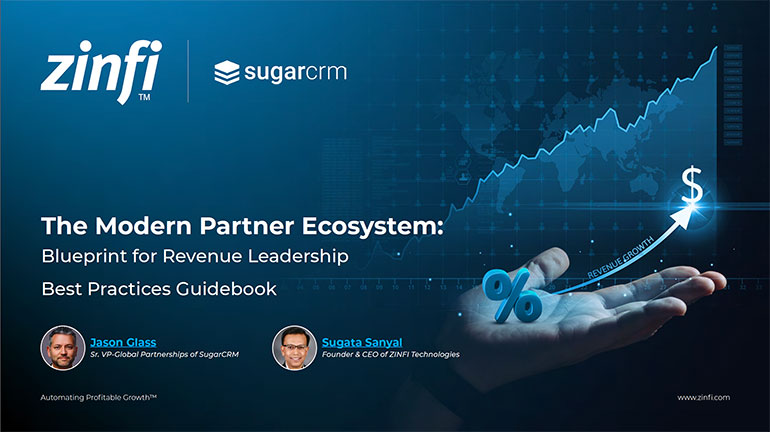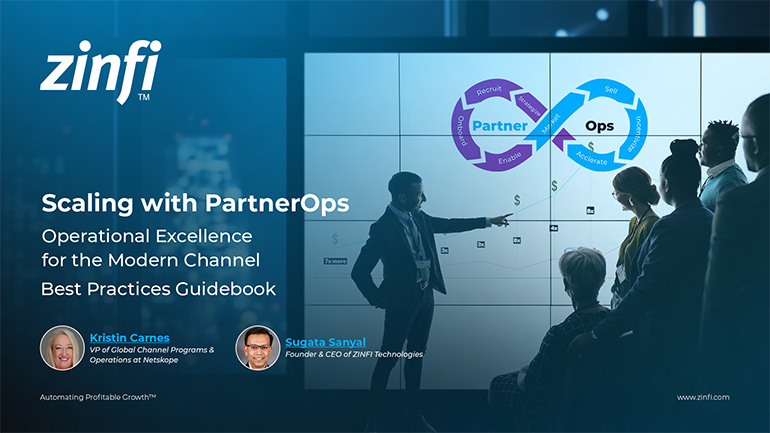Best Practices Articles

Right Metrics for Your Channel Marketing Management Platform
As a provider of a leading SaaS-based channel marketing management (CMM) platform, we get asked a lot about the right set of metrics an organization should consider when they are deploying such a platform globally. Our answer is always, “It depends.” Do I sound like a lawyer? If I do, then I am sorry, but I am not trying to be mysterious. It is truly an honest answer.
While there are core metrics tied to return on investment (ROI) that any organization should look for to measure the impact from their channel marketing management platform, the answer is not really that straightforward. With that said, let me see if I can lay out a logic and a path that will help your organization pick the right set of metrics to drive ROI from a recently procured channel marketing management platform.
First, let’s briefly define business metrics, and then we’ll discuss the importance of thinking through what makes sense for your organization. As per Merriam-Webster, “metrics” refers to “a standard of measurement.” On online search for “business metrics,” yields the following definition from TechTarget: “A business metric is a quantifiable measure businesses use to track, monitor and assess the success or failure of various business processes.” Or Investopedia: “Metrics are parameters or measures of quantitative assessment used for measurement, comparison or to track performance or production.” All three of these definitions suggest that, when it comes to setting metrics (or measurements) for business activities, the goal is essentially to monitor progress and measure success.
To clearly identify the right metrics for the deployment of a channel marketing management platform, I would like to focus on two activities associated with business metrics. First, monitor progress. You do that essentially on a core set of input and output metrics. Second, measure success. Essentially, you quantify success in terms of dollars and cents to make sure the investment is providing the anticipated return.
So, let’s begin with a set of metrics that you may want to consider monitoring. Typically, when you are deploying a channel marketing management platform, you will need to consider three main phases of deployment. For each phase, you should have clear business objectives that define what you are trying to achieve. Once you have your objectives, then and only you can establish metrics to monitor progress and measure success. So, let’s go through these three phases in sequential order, but at the same time let’s also address both business objectives and business metrics.
-
Launch phase – During this phase, the primary goal is to drive quick success so that you can show progress, build buy-in and generate excitement within your organization and share success. It is essential to pick a pilot group of partners—ideally, in a large horizontal market segment—where you can launch, learn, adapt and tweak for ramp.Your goal will be to drive utilization of your channel marketing management platform as broadly as or narrowly as you think necessary. However, instead of worrying about the end state, let’s keep the focus on near-term success. We have repeatedly seen companies that try to launch with too many objectives and with too broad a vision lose momentum and traction, because they were never able to show success from immediate launch. (Of course, there may be other factors at play as well, including unforeseen internal organizational changes.)Yes, we are all taught to begin with the end result in mind, but if you launch with too broad a scope, the end of your channel marketing management effort may be near. Therefore, while it is important to know where you want to go in the launch phase, it is even more important that the metrics be relatively manageable, logical and measurable over a short period of time. It is absolutely crucial to build organizational support and buy-in. Launching a channel marketing management platform is not easy, and picking the wrong business metrics can kill the program quickly.With this as a backdrop, let’s think about the core input metrics in this phase that should be tied to a subset of your top- or mid-tier partners participating in the program. We have all learned from statistics that to project a pilot program representing a full-scale program you need a representative sample. As you select the metrics to monitor progress, the first parameter you need to think about is how many partners—and which ones—you will invite to use your newly launched channel marketing management platform, and how many are already using it.
If you have a focused channel with a few hundred partners in each region, then picking one representative of each country and about 10% of your target partner base should be a reasonable sample to start with. Once you’ve established this target, you have to think about who to include in this initial rollout. This may sound simple, but it’s not. At the end of the day, your channel marketing management platform needs to add value to a partner’s business and marketing game plan.
No matter how great the platform is and how loaded it is with great content, you cannot force-fit a channel marketing management platform onto every partner. You really need to think through which partners will benefit the most and how they can use the platform to complement the capabilities they already have.
For example, if you want your large partners to leverage the platform, even if your large partners all have in-house marketing automation capabilities of some kind, you should probably think about the specific tools that they would likely be most interested in. Typically, this would include web content syndication, which they can use to showcase your products on their website with relative ease, and collateral co-branding. However, when it comes to running events or integrated multi-touch email or microsite campaigns, chances are they are still going to use their in-house platform. Therefore, you probably shouldn’t pick a group of large partners with in-house capabilities if you are trying to demonstrate the usage of multi-tactic integrated campaigns using your newly deployed channel marketing management platform.
On the other hand, if you are going after medium-to-small-size partners who lack in-house marketing automation and don’t have the capability to develop integrated multi-touch campaigns, then you could absolutely expect them to use various tools and tactics from your newly deployed channel marketing management platform. However, with this group of partners you now have to worry about the campaigns themselves, and what other marketing concierge services you are willing to provide.
While large partners have in-house capabilities and therefore can download co-branded assets and execute, the opposite is true of midsize and small partners: They can leverage your platform, but they are likely to succeed only if you also provide some marketing services – either free of charge or by offering market development funds (MDF) or some other cooperative arrangement. Often we see vendors do the opposite. They expect their large partners to use the platform because the large partners have MDF. Then it turns out those partners do not want to use the platform and find all kinds of excuses to avoid doing so. This is a doubly missed opportunity for you to serve both groups in the right way.
As you can see, then, selecting the right business metrics depends upon first identifying the right strategic approach to deploying your channel marketing management platform. Since everyone’s channel is different, you need to think this part through and make sure that the approach you decide on makes sense specifically for your channel.
Once you have settled on an approach and fully understand what will likely drive partner adoption, then the next goal is to make sure you measure partner usage of various tools and campaigns by partner type, geography, location, etc., carefully examining potential cause-and-effect relationships. For example, if the data you already have indicates that providing incentives correlates with increased adoption, you may want to add incentives to the set of metrics to track.
A typical launch phase lasts three to six months, depending on how transactional or complex your products and solutions are. If the sales cycles are short, you can expect to run a three-month launch phase, but if the sales cycle is long—for example six to twelve months—then you may want to run a six-month launch and roll-out program.
The goal in this first phase is to learn and refine the metrics for the ramp phase. Therefore, it is critical to collect input data—e.g., how many partners you have reached out to, how many signed up to learn, how many were trained and how many ran one or more campaigns. Your channel marketing management platform and your marketing concierge agency should be able to track all of these variables for you in a dynamic fashion.
- Ramp phase – Once you have rolled out your channel marketing management platform in one or two key markets, gathered data related to partner adoption rate, usage and lead generation, the next phase is to put together a solid global roll-out and ramp phase.In this phase, your focus should be on picking three or four horizontal programs, tied to campaigns and sales incentives, across the broadest product portfolio that most partners can sell, and establish a highly scalable partner onboarding, training and execution engine. You should align all concierge activities in two ways:
- First, the partner concierge team should focus on supporting high-value (and high-volume) partners directly by reaching out and making sure they are aware of the kinds of campaigns and other assets that are available. They should also put together multi-quarter execution plans, since most of these partners are building their core business around your solutions. Your channel marketing team and channel account management team should be working very closely with your marketing concierge team in driving this. You should also align sales incentives and rewards behind these partners. Remember—these are the partners that drive a lot of business for you, and you need to make sure they are taken care of.
- Second, you should pick a horizontal program—such as a prospecting blitz—and reach out to the broadest part of your channel with a six-to-nine-month program. This program should be focused around doing a few things right, like having each partner participating in the program syndicate your content syndication showcase, stream social syndication and run an integrated campaign—whether it’s email, microsite or event. There should be rewards and recognition tied to the most active partners who are generating the most inbound leads using search and social campaigns, and who are generating the most opportunities.
The primary goal in this ramp phase is to build a repeatable motion where a broad set of partners are now leveraging your marketing assets and are becoming more familiar with your channel marketing management platform and programs. It is essential that you keep the programs in place and resist the common temptation to change programs every three months. It takes a while for a partner to find out about a program and then execute. Repetition and persistence are essential to driving partner adoption in this phase.
You should also formalize the reward and recognition process by engaging senior leadership from your sales and marketing teams and providing special marketers’ awards during your partner events and in other contexts. Remember, success breeds success. Tracking engagement and success metrics at every possible level—and recognizing and rewarding success when it happens—is essential to maintaining momentum.
Of course, from a business metrics perspective, you should track things like the number of showcases that are being syndicated, the streams that are being socially shared, the number of impressions created using email blasts and other outbound activities. You can also track the number of videos and white papers that are being downloaded. You should be tracking as many input metrics as possible, and your channel marketing management platform should be able to provide these to you in a dynamic fashion.
In addition to these input metrics you must also track output metrics, such as the number of marketing qualified leads (MQL) generated, the number of sales qualified leads (SQL) generated, and the number of opportunities generated that were ultimately registered as deals.
Finally, the holiest of all metrics is sales. Yes, if you can track the dollar amount of the overall investment (platform, programs and people) and tally the sales that you have generated since making that investment, then you have begun to truly track the performance of your investment in your channel marketing management automation. However, it takes around 12 to 18 months for most organization to reach this stage. Consider that most large enterprises operate in a quarterly framework, and 12 to 18 months is only four to six revision cycles. With that in mind, try to select reasonable metrics and targets that you and your organization can realistically hit to build confidence and give yourself opportunities to celebrate success.
-
Optimize phase – Once you have gone through your ramp phase and started to link your input metrics with your output metrics, now is the time to start optimizing performance by varying campaigns, program tactics and incentives.If you have a broad channel, the key is to build on the foundation you have created over the past 12 to 18 months. Don’t try to reinvent the wheel. It takes a while to build momentum in the channel. If something is not working, of course change and fix it. However, if it is working—if, say, partners are logging in and running campaigns and programs—then don’t mess with it too much. Just keep loading campaigns and programs, and drive awareness and adoption via your channel marketing concierge network.Remember, success can be boring, so don’t get distracted when things are working and ramping. It’s important to resist that tendency to wonder whether you are being sufficiently creative or not. We have seen many instances where organizations kill or destroy perfectly high-performing programs just for the sake of change. In many ways, the optimize phase is going to be the hardest phase. You have to think through any possible changes judiciously, and keep your focus on truly understanding cause-and-effect relationships on a global level.Definitely in this phase—and probably in the ramp phase as well—you should put together a detailed partner feedback program. Your concierge team should regularly reach out to your partner base and ask what is working and what is not. Make sure you don’t rely solely on anecdotal feedback. Even the feedback you receive is qualitative, put together a formal survey, use a questionnaire, and gather data in an appropriate way. Don’t let yourself be easily swayed by individual positive or negative feedback.
As I noted earlier, if you are managing a broad channel, you need to be sure you are getting the right feedback and understanding cause-and-effect relationships. Then and only then should you consider making changes. It has taken you nearly 18 months to get to this point after a lot of hard work and investment, so make your decisions based on the data rather than anecdotal information.
The primary metric you should focus on in this phase is return on investment (ROI). Calculate the total dollars invested in the channel marketing management (CMM) platform, along with other program costs—e.g., content creation, program management, concierge investment, and campaign costs tied to telemarketing, advertising and so on. All of your input activities and investments should be pointing directly towards hard sales. The key assumption here is that during the launch and ramp phases, you have put together all necessarily connectivity with your internal business systems for data to flow seamlessly to and from your channel marketing management platform to give you accurate output data.
Now that I have walked you through the three core phases of deployment of a channel marketing management platform and shared with you an approach on how you should be thinking about deployment and core metrics, the next most important consideration is the notion of critical mass. Yes, too often organizations forget that success is a function of expectations, but I would also emphasize that your expectations must be grounded in reality. You may stretch the goal, but you also have to think through what you can expect from your investment, and how fast you can expect to see return. This is possibly the most important metric to think about. The key question to ask is, “How long will I have to wait to fully optimize return from my channel marketing management platform?” The answer should be measured in three phases, as outlined above.
In Phase 1 (launch phase) you should be able to justify the investment you are making in the platform, as well as in the people required to drive adoption. You should clearly see pipeline generated that represents 10 to 20 times the size of your investment. In Phase 2 (ramp phase), this metric should increase to 20x to 30x, and in Phase 3 (the fully optimized phase) you may even see 30x to 40x return on your investment. However, don’t expect to get there in one step. Many companies roll out too fast and set expectations that are too high, only to end up with disappointment, loss of confidence and, worst of all, poor partner satisfaction.
So, when you are thinking about picking the right metrics, the most important thing to consider is the core activities in each phase that make the most sense. Once you have figured out the logic of the roll-out over a one-to-two-year period, then and only then will be able to pick the right metrics and track the right input and output parameters that will truly make a difference.
Summary of Core Metrics for You to Consider – Measured Quarterly
- Input metrics (by country, partner type, etc.) to monitor progress
- Total number of partners selected in the program
- Total number of partners reached out to onboard
- Total number of partners onboarded into the program
- Total number of partners signed up to run campaigns
- Output metrics (by country, partner type, etc.) to monitor progress
- Total number of partners running one or more campaigns
- Total number of email campaigns run
- Total number of event campaigns run
- Total number of syndications (web and social)
- Performance metrics (by country, partner type, campaigns, programs, products etc.) to measure success
- Total number of end user impressions
- Total numbers of MQLs (downloads, video views, etc. – define key lead score for MQL)
- Total number of SQLs (BANT qualified)
- Total number of opportunities
- Total value of opportunities (in $)
- Total value of deals registered (in $)
- Total sales generated (in $)
- Return on investment (ROI) metrics to measure success
- Total $ invested (CMM platform cost + internal management cost + concierge cost + MDF spent)
- Total $ generated from sales
- ROI = generated / invested > 20x
Best Practices Guidebook
 The Channel Sales Playbook: Skills, Strategy, and Growth
The Channel Sales Playbook: Skills, Strategy, and GrowthDownload for FREE
 Blueprints for Vertical Success Best Practices
Blueprints for Vertical Success Best PracticesDownload for FREE
 The Future of Partner Enablement: From Enablement Gaps to Global Advantage
The Future of Partner Enablement: From Enablement Gaps to Global AdvantageDownload for FREE
 Reimagine Sales Development. Build a Smarter Prospecting Engine
Reimagine Sales Development. Build a Smarter Prospecting EngineDownload for FREE
 The Zero Trust Imperative: Fortifying Enterprise Security Against AI-Driven Threats
The Zero Trust Imperative: Fortifying Enterprise Security Against AI-Driven ThreatsDownload for FREE
 PartnerOps Excellence: The Definitive Guide to Scalable SaaS Ecosystems
PartnerOps Excellence: The Definitive Guide to Scalable SaaS EcosystemsDownload for FREE
 The Modern Partner Ecosystem Best Practices
The Modern Partner Ecosystem Best PracticesDownload for FREE
 Partner Marketing Reimagined: Strategies for Agile, Insight-Led Growth
Partner Marketing Reimagined: Strategies for Agile, Insight-Led GrowthDownload for FREE
 Scaling with PartnerOps Best Pratices
Scaling with PartnerOps Best PraticesDownload for FREE
 Leading with Partner Programs Best Pratices
Leading with Partner Programs Best PraticesDownload for FREE
 The Partner-First Blueprint: Scaling Trust, Intelligence, and Ecosystem Growth
The Partner-First Blueprint: Scaling Trust, Intelligence, and Ecosystem GrowthDownload for FREE
 Unlock Scalable Growth with The Partner Marketing Growth Blueprint
Unlock Scalable Growth with The Partner Marketing Growth BlueprintDownload for FREE
 From TikTok to LinkedIn: Social Selling Across the Generational Divide
From TikTok to LinkedIn: Social Selling Across the Generational DivideDownload for FREE
 Scaling Partner Ecosystems: From Enablement to Intelligence
Scaling Partner Ecosystems: From Enablement to IntelligenceDownload for FREE
 The Ultimate Guide to Partner Marketing Success Best Practices
The Ultimate Guide to Partner Marketing Success Best PracticesDownload for FREE
 How to Start and Scale Partner Ecosystems Best Practices
How to Start and Scale Partner Ecosystems Best PracticesDownload for FREE
 The Evolution of PartnerOps: Past, Present & Future Best Practices
The Evolution of PartnerOps: Past, Present & Future Best PracticesDownload for FREE







